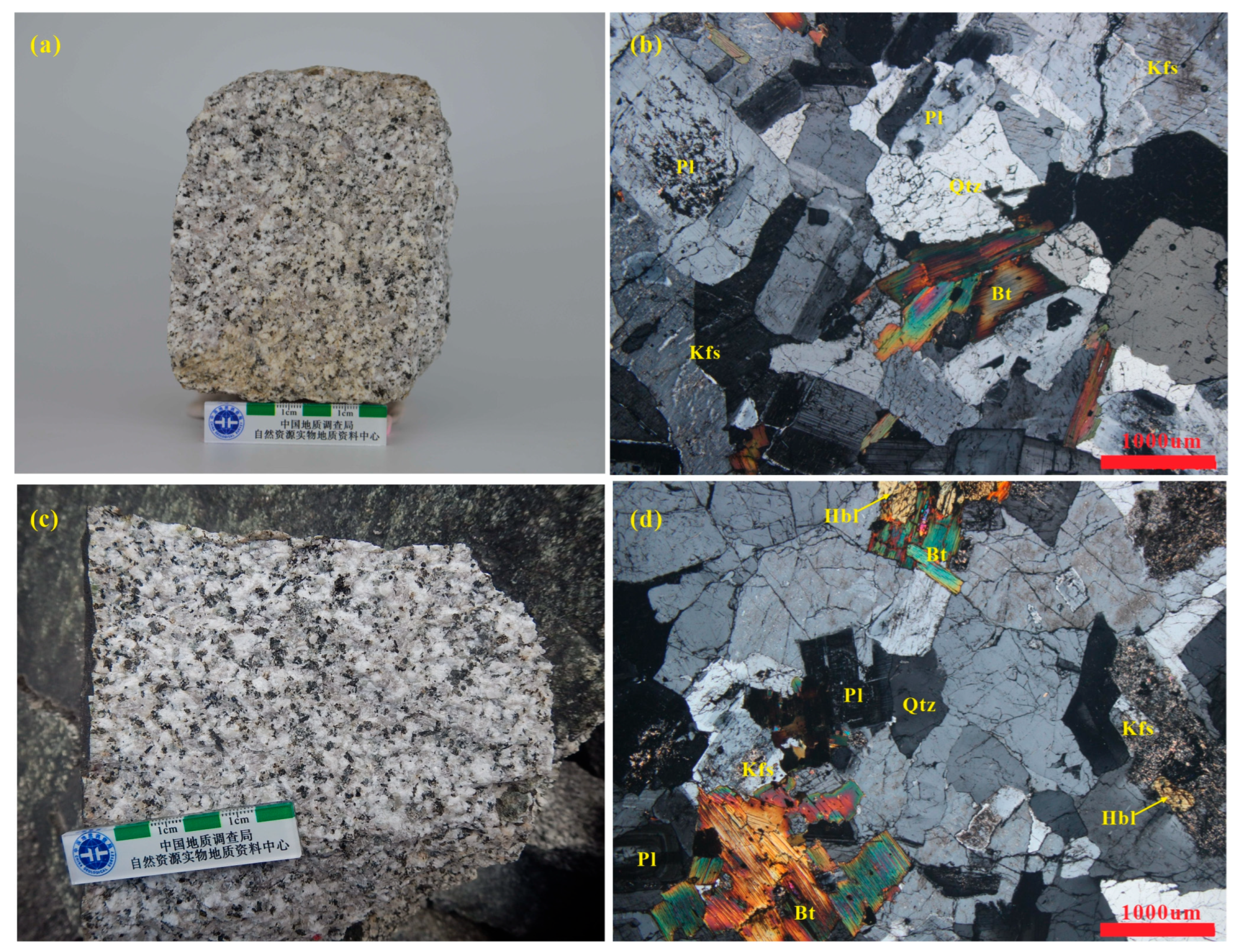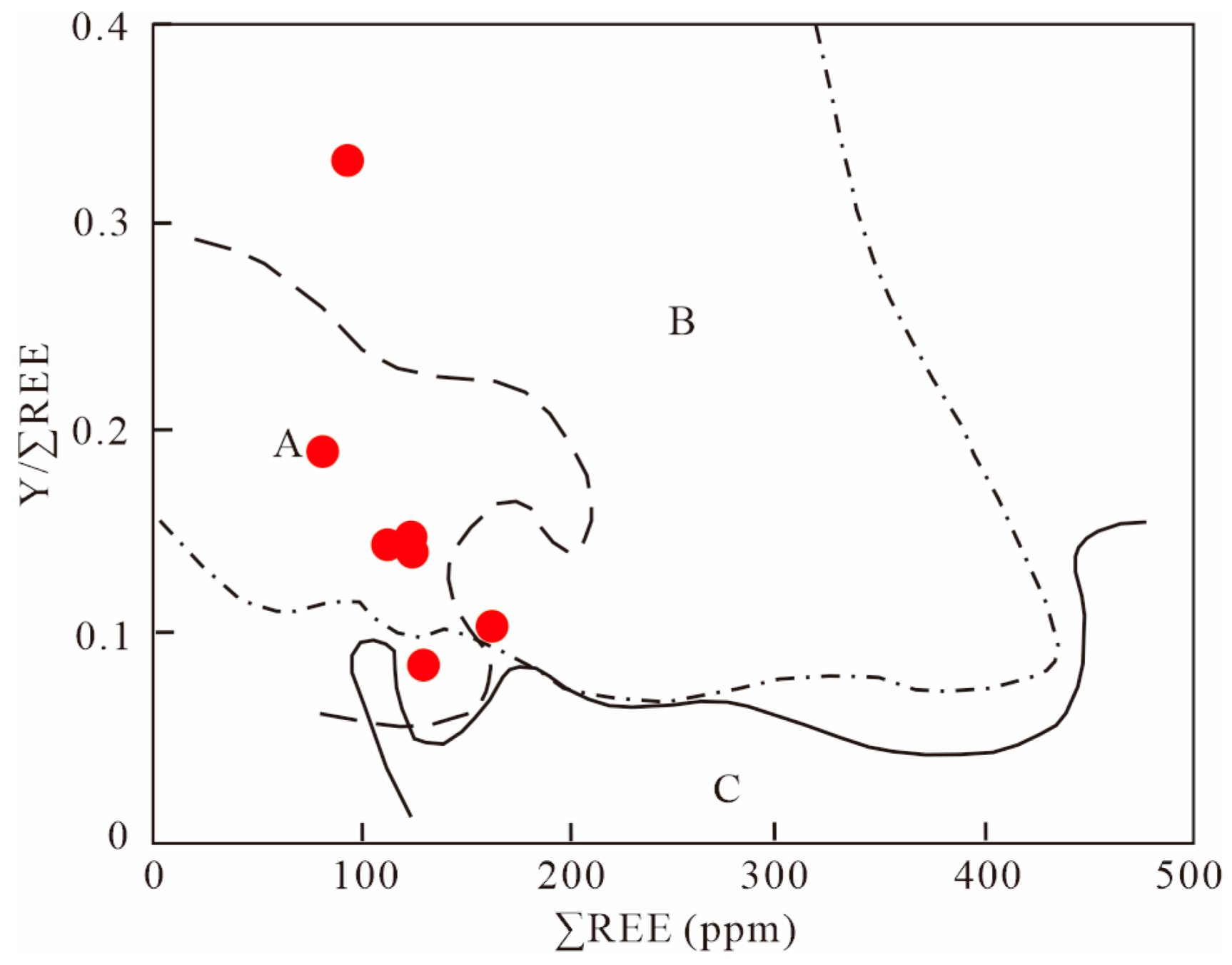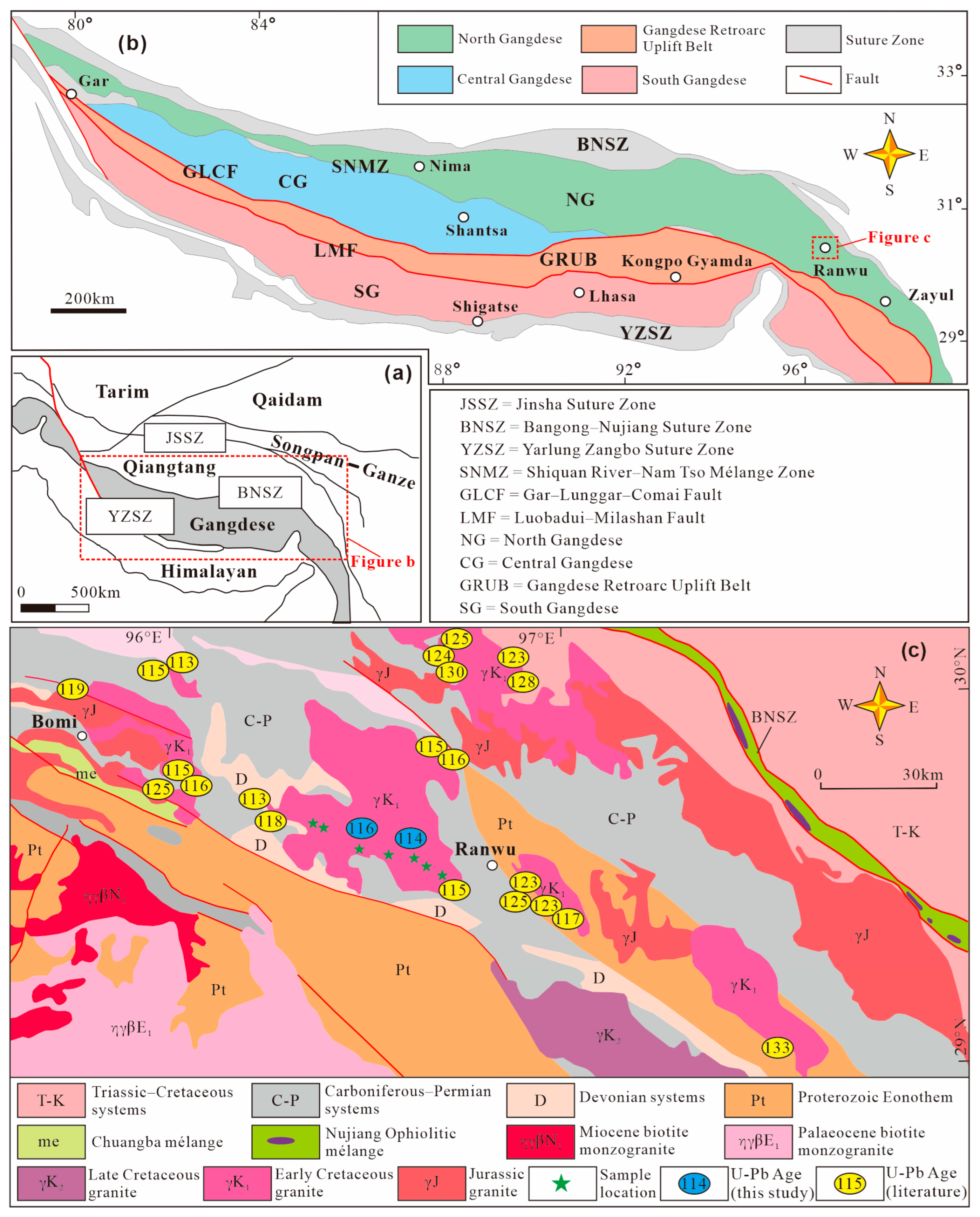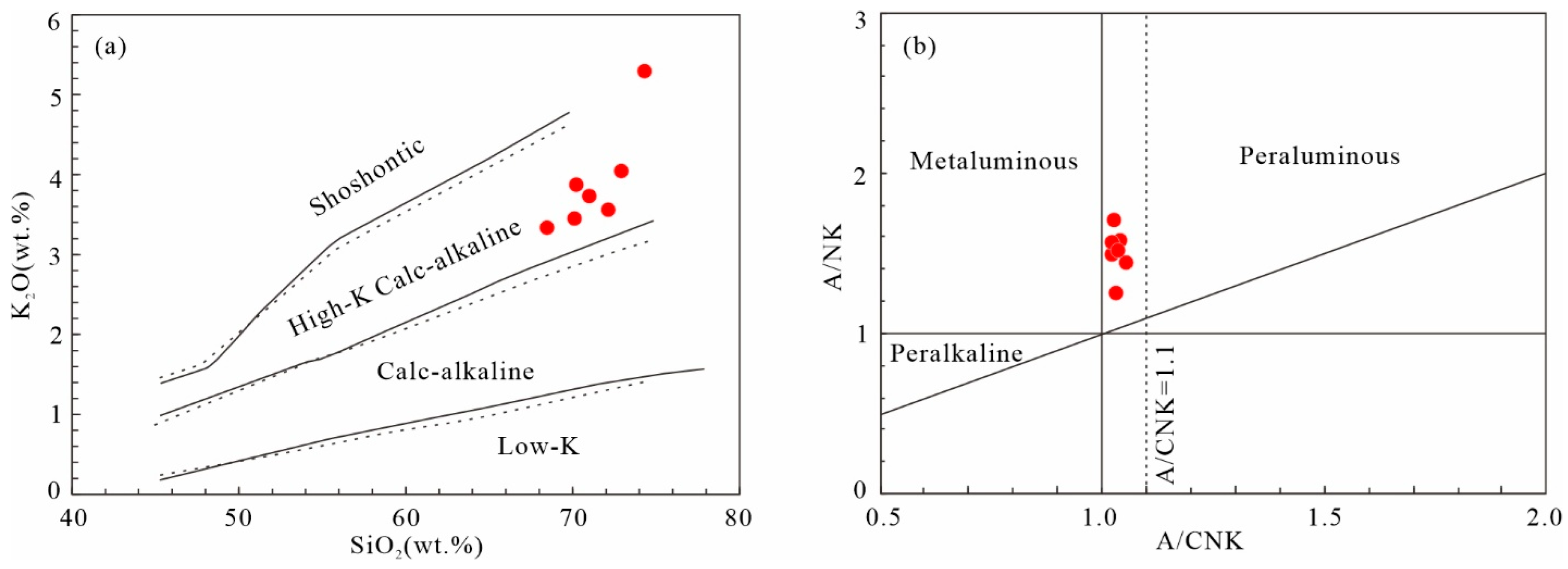Chronology, Geochemistry, and Tectonic Implications of Early Cretaceous Granitoids in the Ranwu Area, Eastern Gangdese Belt
Abstract
1. Introduction
2. Regional Geological Setting
3. Petrographic Characteristics
4. Analytical Methods and Results
4.1. Zircon U–Pb Geochronology Results
4.2. Zircon Hf Isotopic Characteristics
4.3. Whole-Rock Major- and Trace-Element Characteristics
5. Discussion
5.1. Petrogenetic Type
5.2. Magma Source
5.3. Tectonic Setting of Magma Formation

6. Conclusions
Supplementary Materials
Author Contributions
Funding
Data Availability Statement
Acknowledgments
Conflicts of Interest
References
- Pearce, J.A.; Mei, H.J. Volcanic rocks of the 1985 Tibet Geotraverse: Lhasa to Golmud. Philos. Trans. R. Soc. Lond. Ser. A Math. Phys. Sci. 1988, 327, 169–201. [Google Scholar]
- Mo, X.X.; Dong, G.C.; Zhao, Z.D.; Zhou, S.; Wang, L.L.; Qiu, R.Z.; Zhang, F.Q. Spatial and temporal distribution and characteristics of granitoids in the Gangdese, Tibet and implication for crustal growth and evolution. Geol. J. China Univ. 2005, 11, 281–290. [Google Scholar]
- Dong, G.C.; Mo, X.X.; Zhao, Z.D.; Zhu, D.C.; Xie, X.F.; Dong, M.L. The Neocene magmatism from Namuru intrusion in western Gangdese, Tibet and its tectonic significance. Acta Petrol. Sin. 2011, 27, 1983–1992. [Google Scholar]
- Zhu, D.C.; Mo, X.X.; Niu, Y.L.; Zhao, Z.D.; Wang, L.Q.; Liu, Y.S.; Wu, F.Y. Geochemical investigation of Early Cretaceous igneous rocks along an east-west traverse throughout the central Lhasa Terrane, Tibet. Chem. Geol. 2009, 268, 298–312. [Google Scholar] [CrossRef]
- Pan, G.T.; Mo, X.X.; Hou, Z.Q.; Zhu, D.C.; Wang, L.Q.; Li, G.M.; Zhao, Z.D.; Geng, Q.R.; Liao, Z.L. Spatial-temporal framework of the Gangdese Orogenic Belt and its evolution. Acta Petrol. Sin. 2006, 22, 521–533. [Google Scholar]
- Zhu, D.C.; Pan, G.T.; Mo, X.X.; Wang, L.Q.; Liao, Z.L.; Zhao, Z.D.; Dong, G.C.; Zhou, C.Y. Late Jurassic-Early Cretaceous geodynamic setting in middle-northern Gangdese: New insights from volcanic rocks. Acta Petrol. Sin. 2006, 22, 534–546. [Google Scholar]
- Zhu, D.C.; Pan, G.T.; Wang, L.Q.; Mo, X.X.; Zhao, Z.D.; Zhou, C.Y.; Liao, Z.L.; Dong, G.C.; Yuan, S.H. Tempo-spatial variations of Mesozoic magmatic rocks in the Gangdese belt, Xizang, with a discussion of geodynamic setting-related issues. Geol. Bull. China 2008, 27, 1535–1550. [Google Scholar]
- Chiu, H.Y.; Chung, S.L.; Wu, F.Y.; Liu, D.Y.; Liang, Y.H.; Lin, I.J.; Iizuka, Y.; Xie, L.W.; Wang, Y.B.; Chu, M.F. Zircon U-Pb and Hf isotopic constraints from eastern Trans Himalayan batholiths on the precollisional magmatic and tectonic evolution in southern Tibet. Tectonophysics 2009, 477, 3–19. [Google Scholar] [CrossRef]
- Ding, L.; Lai, Q.Z. New geological evidence of crustal thickening in the Gangdese block prior to the Indo-Asian collision. Chin. Sci. Bull. 2003, 48, 1604–1610. [Google Scholar] [CrossRef]
- Kapp, P.; Murphy, M.A.; Yin, A.; Harrison, T.M.; Ding, L.; Guo, J.H. Mesozoic and Cenozoic tectonic evolution of the Shiquanhe area of western Tibet. Tectonics 2003, 22, 1029. [Google Scholar] [CrossRef]
- Zhu, D.C.; Mo, X.X.; Wang, L.Q.; Zhao, Z.D.; Niu, Y.L.; Zhou, C.Y.; Yang, Y.H. Petrogenesis of highly fractionated I-type granites in the Zayu area of eastern Gangdese, Tibet: Constraints from zircon U-Pb geochronology, geochemistry and Sr-Nd-Hf isotopes. Sci. China Ser. D Earth Sci. 2009, 52, 1223–1239. [Google Scholar] [CrossRef]
- He, Z.H.; Yang, D.M.; Wang, T.W. The determination of early Cretaceous post-collision granitoids in Sangba area of Gangdese tectonic belt and its tectonic significance. Acta Petrol. Mineral. 2006, 25, 185–193. [Google Scholar]
- Zhang, K.J.; Xia, B.; Xia, B.D.; Wang, G.M.; Zhang, M.Q.; Li, Y.T.; Ye, H.F. Sedimentologic Evidence for Early Cretaceous Back-arc Rifting of the Gangdese Magmatic Arc, Tibet, Western China. Acta Sedimentol. Sin. 2003, 21, 31–37. [Google Scholar]
- Liu, M.; Zhu, D.C.; Zhao, Z.D.; Wang, L.Q.; Mo, X.X.; Zhou, C.Y. Early Cretaceous magma mixing in Ranwu Area of Eastern Gangdese, Tibet: Evidence from zircon SHRIMP U-Pb age and Hf isotopic composition. Earth Sci. Front. 2009, 16, 152–160. [Google Scholar]
- Dong, Y.S.; Li, C.; Chen, H.; Chen, W.; Zhang, Y. Study on geochronology and its geological significance of the Demala Group complex in Chayu area, Southeast Tibetan Plateau. Acta Petrol. Sin. 2011, 27, 1198–1208. [Google Scholar]
- Xiao, D.; Yang, X.; Teng, C.; Cheng, T.; Zhu, N.; Cao, J. Early Cretaceous A-Type Acidic Magmatic Belt in Northern Lhasa Block: Implications for the Evolution of the Bangong–Nujiang Ocean Lithosphere. Minerals 2024, 14, 681. [Google Scholar] [CrossRef]
- Dong, X.H.; Peng, T.P.; Fan, W.; Zhao, G.C.; Zhang, J.Y.; Liu, B.B.; Gao, J.F.; Peng, B.X.; Liang, X.R.; Zeng, W.; et al. Origin and tectonic implications of Early Cretaceous high- and low-Mg series rocks and mafic enclaves in the Bomi–Chayu Fold Belt, SE Tibet. Lithos 2019, 334–335, 102–116. [Google Scholar] [CrossRef]
- Liu, Y.S.; Hu, Z.C.; Gao, S.; Gunther, D.; Xu, J.; Gao, C.G.; Chen, H.H. In situ analysis of major and trace elements of anhydrous minerals by LA-ICP-MS without applying an internalstandard. Chem. Geol. 2008, 257, 34–43. [Google Scholar] [CrossRef]
- Liu, Y.S.; Gao, S.; Hu, Z.C.; Gao, C.G.; Zong, K.Q.; Wang, D.B. Continental and oceanic crust recycling-induced melt-peridotite interactions in the Trans-North China Orogen: U-Pb dating, Hf isotopes and trace elements in zircons of mantle xenoliths. J. Petrol. 2010, 51, 537–571. [Google Scholar] [CrossRef]
- Andersen, T. Correction of common lead in U-Pb analyses that do not report 204Pb. Chem. Geol. 2002, 192, 59–79. [Google Scholar] [CrossRef]
- Ludwig, K.R. ISOPLOT 3.0: A Geochronological Toolkit for Microsoft Excel; BGC Special Publication No. 4; Berkeley Geochronology Center: Berkeley, CA, USA, 2003; 70p. [Google Scholar]
- Xu, P.; Wu, F.Y.; Xie, L.W.; Yang, Y.H. Hf isotopic compositions of the standard zircons for U-Pb dating. Chin. Sci. Bull. 2004, 49, 1642–1648. [Google Scholar] [CrossRef]
- Soderlund, U.; Patchett, P.J.; Vervoort, J.D.; Isachsen, C.E. The 176Lu decay constant determined by Lu–Hf and U–Pb isotope systematics of Precambrian mafic intrusions. Earth Planet. Sci. Lett. 2004, 219, 311–324. [Google Scholar] [CrossRef]
- Blichert-Toft, J.; Albarede, F. The Lu-Hf isotope geochemistry of chondrites and the evolution of the mantle-crust system. Earth Planet. Sci. Lett. 1997, 148, 243–258. [Google Scholar] [CrossRef]
- Griffin, W.L.; Pearson, N.J.; Belousova, E.; Jackson, S.E.; van Achterbergh, E.; O’Reilly, S.Y.; Shee, S.R. The Hf isotope composition of cratonic mantle: LAM-MC-ICPMS analysis of zircon megacrysts in kimberlites. Geochim. Cosmochim. Acta 2000, 64, 133–147. [Google Scholar] [CrossRef]
- Hoskin, P.W.; Schaltegger, U. The composition of zircon and igneous and metamorphic petrogenesis. Rev. Mineral. Geochem. 2003, 53, 27–62. [Google Scholar] [CrossRef]
- Sun, S.S.; McDonough, W.F. Chemical and isotopic systematics of oceanic basalts: Implications for mantle composition and processes. Geol. Soc. Lond. Special. Publ. 1989, 42, 313–345. [Google Scholar] [CrossRef]
- Peccerillo, A.; Taylor, S.R. Geochemistry of Eocene calc-alkaline volcanic rocks from the Kastamonu area, Northern Turkey. Contrib. Mineral. Petrol. 1976, 58, 63–81. [Google Scholar] [CrossRef]
- Maniar, P.D.; Piccoli, P.M. Tectonic discrimination of granitoids. GSA Bull. 1989, 101, 635–643. [Google Scholar] [CrossRef]
- Wu, F.Y.; Li, X.H.; Yang, J.H.; Zheng, Y.F. Discussions on the petrogenesis of granites. Acta Petrol. Sin. 2007, 23, 1217–1238. [Google Scholar]
- Ma, H.W. Discrimination of genetic types of granitoid rocks. Acta Petrol. Sin. 1992, 8, 341–350. [Google Scholar]
- Whalen, J.; Currie, K.; Chappell, B. A-type granites: Geochemical characteristics, discrimination and petrogenesis. Contrib. Miner. Petrol. 1987, 95, 407–419. [Google Scholar] [CrossRef]
- Watson, E.B.; Harrison, T.M. Zircon saturation revisited: Temperature and compositional effects in variety of crustal magma types. Earth Planet. Sci. Lett. 1983, 64, 295–304. [Google Scholar] [CrossRef]
- King, P.L.; White, A.J.R.; Chappell, B.W.; Allen, C.M. Characterization and origin of aluminous A-type granites from the Lachlan Fold Belt, southeastern Australia. J. Petrol. 1997, 38, 371–391. [Google Scholar] [CrossRef]
- Zen, E.A. Aluminum enrichment in silicate melts by fractional crystallization: Some mineralogic and petrographic constraints. J. Petrol. 1986, 27, 1095–1117. [Google Scholar] [CrossRef]
- Li, X.H.; Li, Z.X.; Li, W.X.; Yuan, C.; Wei, G.; Qi, C. U-Pb zircon, geochemical and Sr-Nd-Hf isotopic constraints on age and origin of Jurassic I and A-type granites from central Guangdong, SE China: A major igneous event in respond to foundering of a subducted flat-slab? Lithos 2007, 96, 186–204. [Google Scholar] [CrossRef]
- Wolf, M.B.; London, D. Apatite dissolution into peraluminous haplogranitic melts: An experimental study of solubilities and mechanism. Geochim. Cosmochim. Acta 1994, 58, 4127–4145. [Google Scholar] [CrossRef]
- Zhu, D.C.; Mo, X.X.; Niu, Y.L.; Zhao, Z.D.; Wang, L.Q.; Pan, G.T.; Wu, F.Y. Zircon U-Pb dating and in-situ Hf isotopic analysis of Permian peraluminous granite in the Lhasa Terrane, southern Tibet: Implications for Permian collisional orogeny and paleogeography. Tectonophysics 2009, 469, 48–60. [Google Scholar] [CrossRef]
- Chappell, B.W. Aluminium saturation in I- and S-type granites and the characterization of fractionated haplogranites. Lithos 1999, 46, 535–551. [Google Scholar] [CrossRef]
- Wu, F.Y.; Jahn, B.M.; Wilder, S.A.; Lo, C.H.; Yui, T.F.; Lin, Q.; Ge, W.C.; Sun, D.Y. Highly fractionated I-type granites in NE China (I): Geochronology and petrogenesis. Lithos 2003, 66, 241–273. [Google Scholar] [CrossRef]
- Nakada, S.; Takahashi, M. Regional variation in chemistry of the Miocene intermediate to felsic magmas in the Outer Zone and the Setouchi Province of Southwest Japan. J. Geol. Soc. Jpn. 1979, 85, 571–582. [Google Scholar] [CrossRef]
- Kinny, P.D.; Maas, R. Lu-Hf and Sm-Nd Isotope Systems in Zircon. Rev. Mineral. Geochem. 2003, 53, 327–341. [Google Scholar] [CrossRef]
- Belousova, E.A.; Griffin, W.L.; O’Reilly, S.Y. Zircon crystal morphology, trace element signatures and Hf isotope compositionasa tool for petrogenetic modelling: Examples from eastern Australian granitoids. J. Petrol. 2006, 47, 329–353. [Google Scholar] [CrossRef]
- Andersen, T.; Griffin, W.L.; Sylvester, A.G. Sveconorwegian crustal under plating in Southwestern Fennoscandia: LAM-ICPMS U-Pb and Lu-Hf isotope evidence from granites and gneisses in Telemark, Southern Norway. Lithos 2007, 93, 273–287. [Google Scholar] [CrossRef]
- Ji, W.Q.; Wu, F.Y.; Chung, S.L.; Li, J.X.; Liu, C.Z. Zircon U-Pb geochronology and Hf isotopic constraints on petrogenesis of the Gangdese batholith, southern Tibet. Chem. Geol. 2009, 262, 229–245. [Google Scholar] [CrossRef]
- Kemp, A.I.S.; Hawkesworth, C.J.; Foster, G.L.; Paterson, B.A.; Woodhead, J.D.; Hergt, J.M.; Gray, C.M.; Whitehouse, M.J. Magmatic and crustal differentiation history of granitic rocks from Hf-O isotopes in zircon. Science 2007, 315, 980–983. [Google Scholar] [CrossRef] [PubMed]
- Collins, W.J.; Richards, S.W. Geodynamic significance of S-I type granites in circum-Pacific orogens. Geology 2008, 36, 559–562. [Google Scholar] [CrossRef]
- Chappell, B.W.; Stephens, W.E. Origin of infracrustal (I-type) granite magmas. Earth Environ. Sci. Trans. R. Soc. Edinb. 1988, 79, 71–86. [Google Scholar] [CrossRef]
- Zhu, D.C.; Zhao, Z.D.; Niu, Y.L.; Mo, X.X.; Chung, S.; Hou, Z.Q.; Wang, L.Q.; Wu, F.Y. The Lhasa Terrane: Record of a microcontinent and its histories of drift and growth. Earth Planet. Sci. Lett. 2011, 301, 241–255. [Google Scholar] [CrossRef]
- Zhu, D.C.; Zhao, Z.D.; Niu, Y.L.; Dilek, Y.; Hou, Z.Q.; Mo, X.X. The origin and pre-Cenozoic evolution of the Tibetan Plateau. Gondwana Res. 2013, 23, 1429–1454. [Google Scholar] [CrossRef]
- Lü, B.X.; Wang, Z.; Zhang, N.D.; Duan, J.Z.; Gao, Z.Y.; Shen, G.F.; Pan, C.Y.; Yao, P. Granitoids in the Sanjiang Region (Nujiang-Lancangjiang-Jinshajiang Region) and Their Metallogenic Specialization; Geological Publishing House: Beijing, China, 1993; pp. 169–243. [Google Scholar]
- Zhang, L.L.; Zhu, D.C.; Zhao, Z.D.; Dong, G.C.; Mo, X.X.; Guan, Q.; Liu, M.; Liu, M.H. Petrogenesis of magmatism in the Baerda region of Northern Gangdese Tibet: Constraints from geochemistry, geochronology and Sr-Nd-Hf isotopes. Acta Petrol. Sin. 2010, 26, 1871–1888. [Google Scholar]
- Chen, Y.; Zhu, D.C.; Zhao, Z.D.; Zhang, L.L.; Liu, M.; Yu, F.; Guan, Q.; Mo, X.X. Geochronology, geochemistry and petrogenesis of the Bamco andesites from the northern Gangdese, Tibet. Acta Petrol. Sin. 2010, 26, 2193–2206. [Google Scholar]
- Atherton, M.P.; Petford, N. Generation of sodium-rich magmas from newly underplated basaltic crust. Nature 1993, 362, 144–146. [Google Scholar] [CrossRef]
- Rapp, R.P. Heterogenous source regions for Archean granitoids: Experimental and geochemical evidence. Oxf. Monogr. Geol. Geophys. 1997, 35, 267–279. [Google Scholar]
- Mc Carron, J.J.; Smellie, J.L. Tectonic implications of fore-arc magmatism and generation of high-magnesian andesites: Alexander. J. Geol. Soc. 1998, 155, 269–280. [Google Scholar] [CrossRef]
- Xie, Y.W.; Peng, X.J.; Tashi, J.; Namgyal, S.; Yangkyi, T. Recent progress in the study of the Neoproterozoic-Cambrian Bomi Group in the Bomi-zayul area, eastern Tibet, China. Geol. Bull. China. 2007, 26, 81–87. [Google Scholar]
- Mingram, B.; Trumbull, R.B.; Littman, S.; Gerstenberger, H. A petrogenetic study of anorogenic felsic magmatism in the Cretaceous Paresis ring complex, Namibia: Evidence for mixing of crust and mantle-derived components. Lithos 2000, 54, 1–22. [Google Scholar] [CrossRef]
- Ingle, S.; Weis, D.; Scoates, J.S.; Frey, F.A. Relationship between the early Kerguelen plume and continental flood basalts of the paleo-Eastern Gondwanan margins. Earth Planet. Sci. Lett. 2002, 197, 35–50. [Google Scholar] [CrossRef]
- Peccerillo, A.; Barberio, M.R.; Yirgu, G.; Ayalew, D.; Barbieri, M.; Wu, T.W. Relationships between mafic and peralkaline silicic magmatism in continental rift settings: A petrological, geochemical and isotopic study of the gedemsa volcano, central ethiopian rift. J. Petrol. 2003, 44, 2003–2032. [Google Scholar] [CrossRef]
- Bonin, B. Do coeval mafic and felsic magmas in post-collisional to within-plate regimes necessarily imply two contrasting, mantle and crustal, sources? A review. Lithos 2004, 78, 1–24. [Google Scholar] [CrossRef]
- Zhang, Q.; Wang, Y.L.; Jin, W.J.; Jia, X.Q.; Li, C.D. Criteria for the recognition of pre-, syn-and post-orogenic granitic rocks. Geol. Bull. China 2008, 27, 1–18. [Google Scholar]
- Pearce, J.A. Sources and setting of granitic rocks. Episodes 1996, 19, 120–125. [Google Scholar] [CrossRef]
- Barbarin, B. A review of the relationships between granitoid types their origins and their geodynamic environments. Lithos 1999, 46, 605–626. [Google Scholar] [CrossRef]
- Brown, G.C. Calc-alkaline intrusive rocks: Their diversity, evolution, and relation to volcanic arcs. In Andesites-Orogenic Andesites and Related Rocks; Thorpe, R.S., Ed.; John Wiley & Sons: New York, NY, USA, 1982; pp. 437–464. [Google Scholar]
- Li, X.Y.; Ma, R.Z.; Yi, L.W.; He, X.C.; Zhang, J.; Yue, X.Y. The determination and petrogenesis of Early Cretaceous post-collision granitoids in Coqên Tibet. Xinjiang Geol. 2013, 31, 57–64. [Google Scholar]
- Qin, S.; Sun, C.M.; Zhang, J.B.; Zhang, W.; Ding, D.G.; Nima, C.R. LA-ICP-MS zircon U-Pb dating, geochemical characteristics and geological significance of Early Cretaceous granites in the Serirong area of north-central Gangdese, Tibet. Geochimica 2018, 47, 182–195. [Google Scholar]
- Turner, S.; Arnaud, N.; Liu, J.; Rogers, N.; Hawkesworth, C.; Harris, N.; Kelley, S.; Van Calsteren, P.; Deng, W. Post-Collision, shoshonitic volcanism on the Tibetan Plateau: Implications for convective thinning of the lithosphere and the source of ocean island basalts. J. Petrol. 1996, 37, 45–71. [Google Scholar] [CrossRef]
- Miller, C.; Schuster, R.; Klötzli, U.; Frank, W.; Purtscheller, F. Post-collisional potassic and ultrapotassic magmatism in SW Tibet: Geochemical and Sr-Nd-Pb-O isotopic constraints for mantle source characteristics and petrogenesis. J. Petrol. 1999, 40, 1399–1424. [Google Scholar] [CrossRef]
- Gorton, M.P.; Schandl, E.S. From continents to island arcs: A geochemical index of tectonic setting for arc-related and within-plate felsic to intermediate volcanic rocks. Can. Mineral. 2000, 38, 1065–1073. [Google Scholar] [CrossRef]
- Chang, Q.S.; Zhu, D.C.; Zhao, Z.D.; Dong, G.C.; Mo, X.X.; Liu, Y.S.; Hu, Z.C. Zircon U-Pb geochonology and Hf isotopes of the Early Cretaceous Rena-Co rhyolites from southern margin of Qiangtang, Tibet, and their implications. Acta Petrol. Sin. 2011, 27, 2034–2044. [Google Scholar]
- Yuan, C.; Sun, M.; Wilde, S.; Xiao, W.J.; Xu, Y.G.; Long, X.P.; Zhao, G.C. Post-collisional plutons in the Balikun area, East Chinese Tianshan: Evolving magmatism in response to extension and slab break-off. Lithos 2010, 119, 269–288. [Google Scholar] [CrossRef]
- Duretz, T.; Kaus, B.J.P.; Schulmann, K.; Gapais, D.; Kermarrec, J.J. Indentation as an extrusion mechanism of lower crustal rocks: Insight from analogue and numerical modelling, application to the Eastern Bohemian Massif. Lithos 2011, 124, 158–168. [Google Scholar] [CrossRef]
- Rosenbaum, G.; Sandiford, M.; Caulfield, J.; Garrison, J.M. A trapdoor mechanism for slab tearing and melt generation in the northern Andes. Geology 2018, 47, 23–26. [Google Scholar] [CrossRef]








Disclaimer/Publisher’s Note: The statements, opinions and data contained in all publications are solely those of the individual author(s) and contributor(s) and not of MDPI and/or the editor(s). MDPI and/or the editor(s) disclaim responsibility for any injury to people or property resulting from any ideas, methods, instructions or products referred to in the content. |
© 2025 by the authors. Licensee MDPI, Basel, Switzerland. This article is an open access article distributed under the terms and conditions of the Creative Commons Attribution (CC BY) license (https://creativecommons.org/licenses/by/4.0/).
Share and Cite
Yang, X.; Dong, M.; Wang, Y.; Teng, C.; Xiao, D.; Cao, J.; Chen, X.; Shao, J. Chronology, Geochemistry, and Tectonic Implications of Early Cretaceous Granitoids in the Ranwu Area, Eastern Gangdese Belt. Minerals 2025, 15, 1188. https://doi.org/10.3390/min15111188
Yang X, Dong M, Wang Y, Teng C, Xiao D, Cao J, Chen X, Shao J. Chronology, Geochemistry, and Tectonic Implications of Early Cretaceous Granitoids in the Ranwu Area, Eastern Gangdese Belt. Minerals. 2025; 15(11):1188. https://doi.org/10.3390/min15111188
Chicago/Turabian StyleYang, Xinjie, Meiling Dong, Yanyun Wang, Chao Teng, Dian Xiao, Jun Cao, Xiqing Chen, and Jie Shao. 2025. "Chronology, Geochemistry, and Tectonic Implications of Early Cretaceous Granitoids in the Ranwu Area, Eastern Gangdese Belt" Minerals 15, no. 11: 1188. https://doi.org/10.3390/min15111188
APA StyleYang, X., Dong, M., Wang, Y., Teng, C., Xiao, D., Cao, J., Chen, X., & Shao, J. (2025). Chronology, Geochemistry, and Tectonic Implications of Early Cretaceous Granitoids in the Ranwu Area, Eastern Gangdese Belt. Minerals, 15(11), 1188. https://doi.org/10.3390/min15111188







